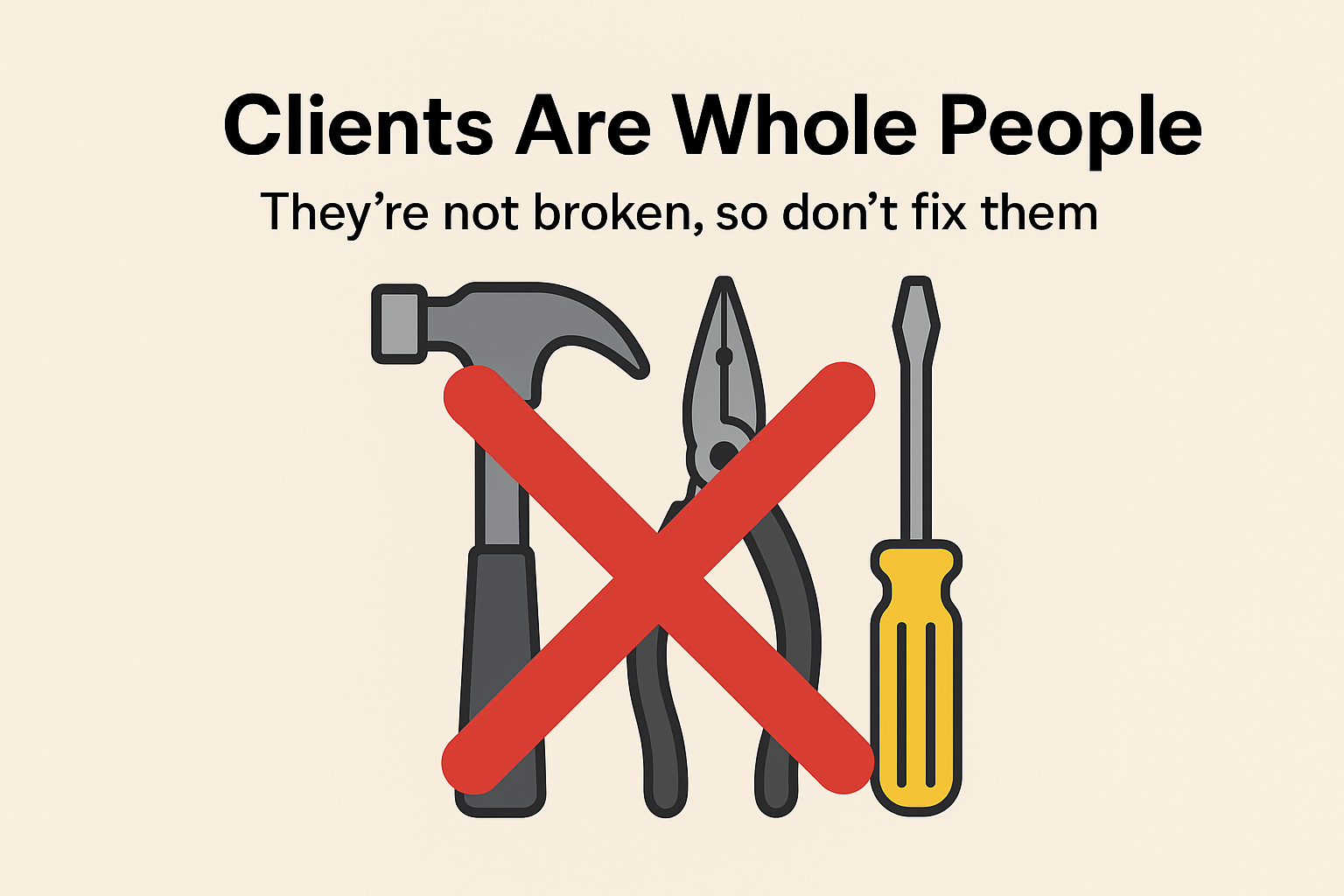Clients Have Something to Offer.
As therapists, we need to remember that our clients are not just receivers of care — they are whole people with something to offer. They have value, in service to life and to others, including us, their therapists. This shift in perspective benefits both client and therapist. It’s the heart of a truly co-regulatory stance in our work — and recognizing this is radical practice.
The Traditional Model: Give Without Expecting
We’re trained to be present, available, and selfless — to help, give, and fix. We’re told to leave our personal experiences and vulnerabilities at the door and to be careful not to blur boundaries by sharing too much.
When I was a new therapist, my focus was on developing competence: creating safety and healthy boundaries, regulating dysregulated clients, doing thoughtful case construction, and cultivating embodiment. Then came the work of acknowledging and repairing my own mistakes in real time — staying regulated and modeling repair in session. In those early years, I had no bandwidth for considering what my clients might have to offer me, beyond a fee and a sense of professional satisfaction.
There is a “fixing” trap. Many of us believe we must fix our clients’ deficits, trauma, pain, or dysfunction. Hidden in that belief is a quiet arrogance — a “top-down” stance that privileges us and diminishes them. It creates a subtle and unfortunate separation when what most people actually need for healing is connection, not correction.
Healing Is Mutual
We are mammals with social nervous systems designed for mutual regulation. Most healing happens more efficiently in connection. Relational trauma — and the shame and grief that often accompany PTSD — depend on connection to heal. PTSD usually arises not just from what happened, but from being left overwhelmed, alone, and ashamed afterward. Our tribe has not been able to provide what we need to heal. (More on this in [Healing Trauma is Collective Work – LINK])
PTSD isn’t simply a pathology in the client; it’s a symptom of what’s been missing. As therapists, we can help restore what’s been lost: connection, resonance, and hope. Clients need to feel our aliveness and our ability to stay steady without worrying that they’re depleting us. That’s how they begin to trust healthy connection and lean into the possibility of deep healing.
The Deep Need to Matter
Every person needs to feel esteemed as a person. Trauma survivors often carry immense shame — the belief that their pain makes them unworthy and their intense need makes them toxic. They may share their story and feel some relief in being heard, but underneath, there’s a deeper need: to know that they still have something to offer.
For many, the idea that they could matter to their therapist feels unimaginable. But they do have something valuable to offer us. And our honest, explicit acknowledgment — that their presence touches or nourishes us — can be profoundly reparative.
When clients feel that they matter, healing begins not as a one-way service but as a shared human experience.
Can We Let Clients Affect Us?
The old model — one person helping the other without expecting anything back — falls short when we’re addressing trauma and toxic shame. When we truly value our clients, they feel it.
I find that many of my clients now look forward to therapy because it’s a place where they feel valued, not just helped. They come not only to face their pain, but also to participate in a living, reciprocal relationship.
We can allow our clients to make a real and meaningful difference to us — and say so. When we show up with authentic presence — our body, our nervous system, our capacity for coregulatory connection — we invite theirs.
If we expect nothing back, we risk treating clients as if they are worthless. But when we allow ourselves to be touched by their humanity, something shifts. They may not offer us new insights, but they do offer something essential: another living nervous system, capable of developing resonance and mutual regulation.
Allowing clients to affect us doesn’t mean collapsing boundaries; it means refining them. It deepens discernment about what we share and how we stay present. This mutual resonance helps prevent burnout and keeps our work enlivening rather than draining.
When we compartmentalize all our feelings “for their benefit,” we lose access to the very field of connection that heals. But when we share appropriate, genuine feelings, we stay in our humanity — responsive, awake, and alive.
When we let clients touch us, we both come more alive.
Expecting Nourishment
Part of our ongoing evolution as therapists is learning to expect nourishment — even from trauma survivors. This isn’t about taking from them; it’s about recognizing that connection itself is the medicine.
When we orient to mutual nourishment, the relational field becomes alive. Both nervous systems participate in healing. We step out of the hierarchy of fixer and fixed, and into the shared humanity that dissolves deep shame.
Mutual nourishment allows us to stay present over the long arc of this work. It keeps our practice from becoming mechanical or draining. It reminds us that therapy is not a performance of expertise — it’s a living relationship, rooted in respect for the wholeness of both people in the room.
